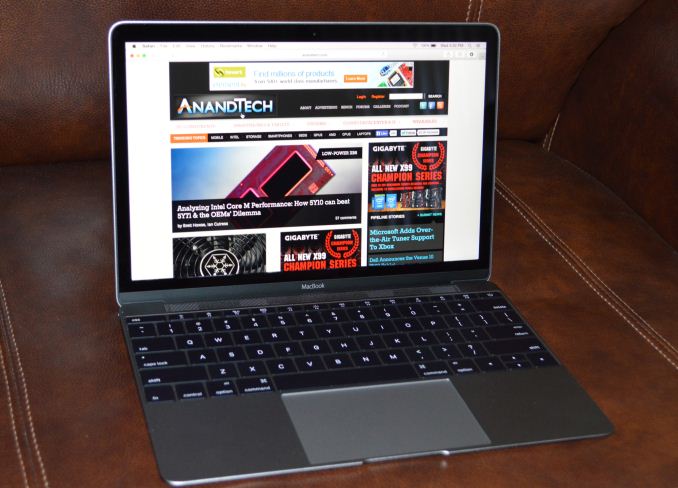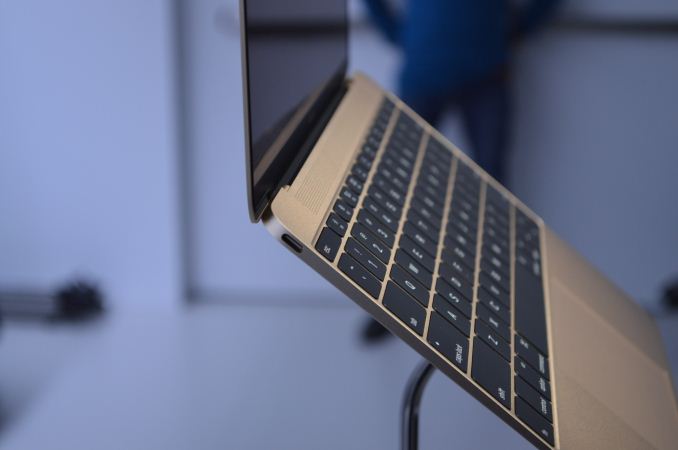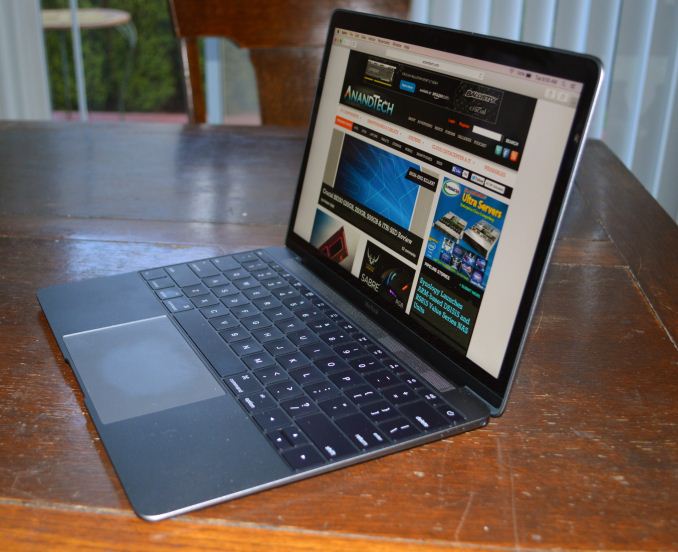The 2015 MacBook Review
by Ryan Smith on April 14, 2015 10:15 AM ESTFinal Words
Bringing this MacBook review to a close, I’m going to start where I left off in our introduction, which was the concept of the laptop/tablet crossover. The idea of laptops and tablets crossing over is no longer merely an idea, but now it is reality. Apple for their part may not be doing any kind of wild 2-in-1 transforming design, or even pushing the concept of a touchscreen OS X device, but they have clearly tapped their immense experience with tablets in putting together the new MacBook.
From a design perspective then the end product is clearly a Mac laptop, but it’s a Mac laptop that’s more tablet-like than any before it. From the small size, to the low weight, the choice of a Core M processor, the passive, fanless cooling system, and of course the choice of metallic colors, the MacBook pushes against the line that separates Apple’s laptops from their tablets.
There are of course numerous benefits and drawbacks from this, with some of them being obvious and others a bit more subtle. The biggest benefit of course is the size; the MacBook is a 0.92kg, 1.31cm thick professional grade Mac laptop, with many of great features that come with such a device. If the Retina MacBook Pro were miniaturized, then it would end up looking and behaving a lot like the MacBook that Apple is delivering today.
The biggest drawback in turn is what you give up to pack a full Mac into such a small laptop. Make no mistake, Core M is no slouch, and in bursting workloads can perform very well. But when faced with sustained workloads, a 4.5W processor can only go so far, and it’s not going to be able – nor is it meant to – keep up with the more powerful processors found in the MacBook Air and Retina MacBook Pro. The end result then is performance that’s anywhere between on-par with last year’s MacBook Air to the MacBook Air of a few years ago, depending on the specific task being run.
Meanwhile in the middle are a multitude of new technologies being first introduced in this generation. The new keyboard and its butterfly mechanism are certainly different, and the reduced key travel takes some getting used to, but once accustomed to it I like the stability of the keys. Similarly, the new Force Touch Trackpad is mechanically very different, and I’m still not sold on whether Apple is going to be able to find too many useful situations for the force touch capabilities. But on the other hand I’m definitely impressed with how natural the trackpad feels despite lacking a true switch mechanism and recreating that feel with an electromagnet instead.
Also deserving of attention is the MacBook’s 12” Retina IPS display. Particularly since the move to Retina Apple has been doing a great job on producing high quality pro displays, and the MacBook’s doesn’t fail to impress. The MacBook’s display’s out of the box performance is among the best we’ve ever seen, rivaling (and at times exceeding) the Retina MacBook Pro, which is to say that the end product is a very accurate, very sharp display. Mac users have been clamoring for a Mac ultra-portable with a Retina display for some time now, and although I don’t think the MacBook was quite what everyone had in mind, the MacBook’s display certainly is.
And then there’s Apple’s introduction of the USB Type-C port, which on such a small laptop like the MacBook takes on a whole new importance. Apple has always been on the cutting edge of I/O and their rapid adoption of USB Type-C is no exception. Relying on it for both I/O and charging is in turn a logical move given the interface’s capabilities, but I would also have to argue that Apple has taken it too far with just a single Type-C port. The Type-C port was the right call – teething issues and all – but Apple has unnecessarily hindered the MacBook by only giving it the single port. Even with its small, ultra-portable design there are still times where it’s desirable to charge the MacBook and use it with an external peripheral at the same time.
What we’re left with is a solid, though by no means perfect new entry into the MacBook family. I hesitate to call the MacBook a niche product since niche implies highly specialized when in fact the MacBook isn’t quite that specialized – it’s just small – but it’s clearly one product in Apple’s larger lineup. What the MacBook isn’t is a replacement for the Retina MacBook Pro or MacBook Air – at least not today – as it’s a laptop for users who already have other laptops or desktops; it is a second computer, not a first one. And admittedly this is the same designation that was applied to the MacBook Air on its launch several years ago, but as the Air’s performance has improved over the years and it was shifted to Apple’s entry-level laptop, it has certainly become the sole computer for an increasing portion of its user base.
Speaking solely for myself here, I’ve come away rather impressed with the MacBook. As an 11” Ultrabook user I already have a fondness for the weight and size of the form factor, and as a journalist frequently carrying around a laptop to trade shows and meetings I particularly appreciate the reduction in weight. The regression in performance is unfortunate, but the combination of weight, battery life, the Retina display, and the keyboard in my mind more than make up for the performance the MacBook can’t offer. After all, I have a workstation for when I need performance; what the MacBook fulfills is delivering acceptable performance when I’m away from that workstation and need portability over performance.
Briefly, I also want to touch on price. The MacBook’s $1299 starting price tag is very much an Apple price tag – which is to say expensive – however it’s also one that goes hand-in-hand with markedly improved base specifications for an Apple laptop. The 11” MacBook Air starts at just $899, but as Apple’s entry-level laptop I will also argue until I’m blue in the face that it’s underequipped for 2015; 4GB of RAM and a 128GB SSD aren’t enough. Which is a point I make because after upgrading the Air to a more acceptable 8GB of RAM and a 256GB SSD the price tag is up to $1199, at which point it’s only $100 off of the MacBook. At least compared to the rest of Apple’s lineup I find that the base MacBook isn’t so much expensive as the base MacBook Air is just a bit too cheaply built.
Anyhow, on a broader note, while I doubt Apple was looking quite this far into the future when they created the initial MacBook Air, I get the distinct impression that this is the kind of device they have been building towards. Apple has always been held back by technology to some degree – be it processor size, storage size, or display power requirements – and it’s only now in 2015 that the pieces have come together to allow them to make a laptop this small. I don’t believe this is a stopping point for Apple simply because one way or another they’re going to keep iterating, but compared to the MacBook Air there isn’t the same need nor ability to make a MacBook even smaller.
Which brings me to my final point, which is the future direction of the Apple’s Mac laptop families. The fact that the MacBook is the MacBook, and not the MacBook Nano or some other named MacBook is something I believe is telling. Although there’s clearly a risk in reading too much into Apple’s future plans based on a name alone, I have to seriously wonder where the MacBook and the MacBook Air go from here. Apple still needs an entry-level Mac laptop, but do they need the MacBook Air in particular? Just as the newer MacBook Air rendered the previous generation MacBook redundant in due time, I suspect Apple may intentionally following the same course with the new MacBook. But as to whether that comes to pass, only time will tell.













354 Comments
View All Comments
pliablemoosethebanned - Sunday, June 21, 2015 - link
Ryan, great article, I just got a MacBook, my use case (trading stock options at work during my lunch and breaks) is perfect for this laptop, I commute on the subway and via electric skateboard, and weight savings is important.I tried to use my iPad and find a touch screen is pretty miserable to choose options, same goes for a phone, tried the best Chromebook and the keys started falling off in the first week. (Toshiba Chromebook 2 with the 1080 screen), loved the screen, but the rest of the hardware just didn't cut it. $1K for a Pixel is just a bit too much for a Chromebook, but it was tempting, would have been a sale for Google had they included LTE.
This is day one with the MacBook, hope it stands up.
cyrenaichedon - Friday, August 7, 2015 - link
"if not for the fact that Apple took the time to point this out in their reviewer’s guide"Yeah, the numbers look impressive but in reality, it feels like your typing on a flat surface.
hot kiwi - Wednesday, November 25, 2015 - link
So, I have bought this expensive piece of equipment, having been an apple fan since a decade and all equipment at home from iPhones to the Time capsule and and and from Apple.Well, because of this notebook it is my last Apple product. this MacBook is a waste of money and a nuisance. i arrive at work and have forgotten to take my 30 $ separate adapter with me, so cant not upload my presentation to a USB stick. I wanted to put a large spreadsheet from the computer to a USB drive, but the computer was almost empty on charge, so could not download and charge at the same time. the keyboard is purely experimental and you make type after types due to its minimal action.
Mark my words: Apple made a huge mistake with this product that gave away all the functionality for a minimal weight gain.
Now that Samsung and Microsoft have more than caught up, it is time to make the switch.
never Apple again after this failure.
cinaski33 - Sunday, June 19, 2016 - link
When you buy something you usually pay attention at what you really need. Apple doesn't just the new macbook, but also the macbook pro, that has everything you need for every use and connection.There's no Dell Xps or other good product that can fit your needs if you need something else. Apple has always been forward, and every other company tried (sometime better, sometime worser) to copy.
If anyone had problem and complained about port lack or cpu power (that works fine anyway like other thin notebook thank to the OS X system) it's just for wrong choice.
I have my 13 inches 2015 macbook pro Retina with 16gb ram and 512 hd, payed 1400€, and it kills the Lenovo X250 or the Dell XPS.
So do yourself a present.
Think before buying.